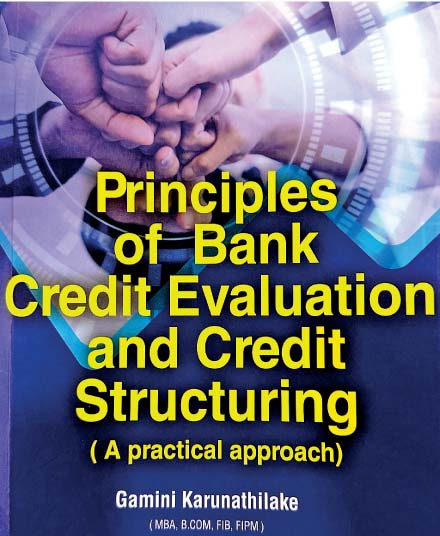Tuesday Apr 08, 2025
Tuesday Apr 08, 2025
Monday, 27 May 2024 00:45 - - {{hitsCtrl.values.hits}}

Gamini Karunathilake

|
 A book on credit evaluation
A book on credit evaluation
Professionals in retirement are used to sharing their experiences in the form of manuals or handbooks with readers. Bankers have been very generous in doing so. The latest to add his name to this group of bankers has been Gamini Karunathilake who had been a senior officer of the Bank of Ceylon and later, the Managing Director of its subsidiary, Merchant Bank of Sri Lanka. He has released the second of such books under the title ‘Principles of Bank Credit Evaluation and Credit Structuring: A Practical Approach’. His first book has also been in the same theme, ‘The Law and Practice of Bank Securities and Recoveries’, published in 2018.
Experiences into a book
Writing a blurb to the present book, the management Guru and founding Director of the Postgraduate Institute of Management, Professor Gunapala Nanayakkara has this opinion about Karunathilake’s work: “The author’s work in designing and operating banking processes, and making decisions to turn around organisations in difficulty, long-term serving as member of many boards of financial organisations, and as a consultant in the field has given him the power of certainty in his writing. He spent most of the work life in institutions such as Bank of Ceylon and Merchant Bank of Sri Lanka where he gathered experience in the area of credit management as a credit officer, credit trainer, credit policy maker, and credit decision maker. In addition, he undertook lecturing in universities and professional institutions, served as examiner and consultant where he sharpened his perspectives of the learner, which has enabled him to look at the issues and constraints from the learner’s point of view”. I agree with Nanayakkara.
I was privileged to write the foreword for the current publication. That was written before the book came in print form. The following review is an updated and expanded version of that foreword.
|
A useful book
As Karunathilake has mentioned in the Preface, the objective of writing the book has been to enhance the competency of credit staff in banks and financial institutions in systematic credit structuring, evaluation, and credit decisions. Since banking knowledge is changing all the time, it is necessary for those engaged in the financial services industry to update their knowledge continuously. To attain this end, Karunathilake has added all the recent developments in credit sanctioning including a chapter on the use of information and communication technology for credit decisions in financial services industry. However, in my view, the book is useful not only to practicing bankers but also to students of banking and the general readers. Those who criticise banks for following unwieldy, time-consuming methods of credit evaluation and sanctioning will learn, by mastering this book, why banks have been compelled to do so.
An overall assessment
The book is divided into eight chapters. In the introductory chapter, Karunathilake has taken his readers through an overview of credit evaluation as practiced today. Since a financial institution must depend on the interest income for its continued operation, credit should be properly evaluated and structured to ensure a secured flow of income to the institution. Because of this reason, the scientific approach to credit evaluation becomes a sine qua non for any credit manager. In this respect, the techniques available and best practices adopted by credit managers have been presented in a brief form enabling him to present the detailed elaboration of same in later chapters.
In this introductory part, Karunathilake has outlined the main credit products involved in the retail credit market on which most of the financial institutions have concentrated. There are five credit proposals he has outlined here: the extension of retail credit, serving the corporate sector, supporting project financing, self-liquidating credit like hire-purchasing, and meeting the needs of the microfinance sector. Says Karunathilake: “In conclusion, the five categories of credit proposals referred to above should employ a different set of principles to identify risk factors associated with them and to make credit decisions. Those relevant principles are to be discussed in the proceeding chapters of this book.”
|
Historical developments
Chapter 2 has been devoted to a description of the historical developments in the principles of credit evaluation. In the early stage of the development process, financial institutions have evaluated credit proposals based on 3-Cs, namely, capital, character, and capacity. While capital is a physically measurable concept, character involving the values and attitudes of a borrower cannot be known directly; that requires a banker to develop a hawkish eye – known in banking circles as subjecting a loan applicant to an ‘eyeball test’ – through experience. This is the type of credit assessment done by informal moneylenders. They observe the behaviour of a prospective borrower closely to find his enterprise, personal habits, methods of conducting business, and relations with customers for some time before capturing him to their net.
Formal bankers can benefit immensely if they emulate the informal moneylenders in the art of conducting this eyeball test. Capacity of a prospective borrower involves in his personal capacity as a businessman and the capacity of his product lines in the marketplace. Then, as Karunathilake has presented, 3-Cs have been expanded to 5-Cs and later to 6-Cs. In the 5-C principle, conditions and collateral were added anew; when cash-flows were added to it, it became a 6-C principle.
Similarly, several more mnemonics are now being used by credit evaluators: PARTS covering purpose, amount, repayment, terms, and securities, on one side, and CAMPARI which also includes some of the earlier principles. They are character, ability, means, purpose, amount, repayment, and insurance. The process is still evolving, and, in the future, there will be many more mnemonics that will be added to the paraphernalia of credit evaluators.
|
Consumer credit
The principles of consumer credit evaluation have been discussed in detail in Chapter 3. Consumer credit is a major component of any loan portfolio of a banker today because they constitute to largest borrower category. Since they are numerous, the number involved is also unmanageably large. Hence, it will occupy the longest time occupation of a typical banker. However, when the system has been streamlined, it becomes manageable and will be within the control of bankers. Karunathilake has presented those principles in detail in this chapter. And each of these principles has been discussed in detail for lending banker’s guidance. Karunathilake has summarised these complex principles to a single map enabling his readers to grasp it easily. Karunathilake has given detailed guidance on how to interview customers, how to visit their business places, and how to write the ‘back-to-office’ reports. This guidance is essential for a trainee banker who has no other means of getting them except by observing his seniors.
Corporate credit
It is in Chapter 4 that Karunathilake has presented the other side of credit, principles of commercial credit and its evaluation. Commercial credit is availed by business entities that produce a good or a service for sale in the market and earn its livelihood. Consumer credit helps people to buy that output and, hence, is essential for businesses to operate. In addition, commercial credit directly granted to businesses in the form of short-term credit will help a business to continue in production. The medium and long-term credit helps a business to expand its capacity and produce more. Consequently, the proper evaluation of short-term, medium term, and long-term credit is essential for a financial institution to earn its livelihood. Karunathilake has given a detailed description, with numerical examples, of how such credit should be evaluated. As in the previous case, the entire chapter has been summarised graphically in a map at the end.
Financial analysis
Chapter 5 is on the financial analysis necessary for making credit decisions. This knowledge is essential for a banker, but the technical nature of the subject makes him shun it. It is a challenge to present this sophisticated subject in a manner that could be understood by the target reader group. Karunathilake has accomplished this challenge successfully. He has done so by going into the basics, namely, how to understand accounting statements including cash flows, meaning of audit reports, and then, the use of various financial analytical techniques. These analyses have been illustrated by appropriate numerical examples which readers could use for practicing and solidifying their knowledge.
An assessment of cashflows
A concern that has worried both policymakers and bankers alike has been how to direct credit to projects that are subject to a high degree of uncertainty and risk. Hence, collateralising such project financing is necessary to protect the interests of the lenders. However, project promoters, who are, in most cases, startups, are unable to provide collateral acceptable to bankers. Hence, a new area of project financing that has come to focus has been how to extend project financing not based on collateral but on the future cash streams. Chapter 6 has been devoted by Karunathilake to address this issue. He has introduced the basics of projects, how they should be funded via loans and/or equity financing, risks involved, use of feasibility study reports for making project financing decisions, and numerical examples to illustrate his points. This is a comprehensive treatment of the subject given the space limitations in the text.
Restructuring of loans
Chapter 7 is on how to structure a loan by a financial institution. Though not recognised as a core part of credit decisions, it has increasingly become an important subject in present-day lending programs. Karunathilake has presented different loan products, their relative merits and demerits, how they should be applied in practical situations, and how the interests of both the banker and the borrower should be incorporated into credit decisions. If the structuring has not been done properly, no amount of credit granted by a lending institution will serve its purpose.
Use of ICT
Chapter 8 is on how to use the modern information and communication technology for credit decisions by banks. To derive benefits out of ICT, financial institutions are increasingly utilising new apparatuses available to them such as artificial intelligence, machine learning, and blockchain technology, to mention but three important applications. This is the future of banking and unless bankers get ready to meet the challenges posed by it, credit decisions made in financial institutions become sup optimal. Karunathilake has introduced this new area of credit evaluation and financing to his readers. Given its importance in modern-day banking, this chapter can be called the flagship chapter of his textbook.
|
|
|
Deficiencies of the book
What are the deficiencies of the book? I find two which he could have avoided easily. One is that the book does not contain a glossary of terms used. This is very essential for the readers to understand the book as well as consolidate his knowledge. The precise meaning of those terms is also essential if he is to communicate the same to his superiors or juniors. The other deficiency is that it does not contain an index. If a reader wants to find out where a given term has been discussed, he will have to peruse through 377 pages. Finding a needle in a haystack maybe easier than finding the relevant section of the book that discusses the selected term. In this modern era of advanced word-processing, compilation of an index of a book is just pressing one or two buttons of a computer keyboard. In a future edition of the book, Karunathilake may rectify these deficiencies.
Next book?
What should be the next book which Karunathilake should write? The present book is on the structuring of the performing credit. But due to the adversity of the COVID-19 pandemic and the following economic crisis, thousands of borrowers, specifically those in the micro, small, medium enterprise sectors, have run into difficulty of servicing their loans. The Central Bank has made it mandatory that banks should establish business revival units in banks to address this issue. That involves restructuring of problem loans. Perhaps the next book of Karunathilake may be on that theme.
Overall, Karunathilake’s attempt is praiseworthy. Without depending only on his long experience in banks, he has collected and assembled valuable material from numerous sources to enrich the quality of his book. It is with pleasure that I recommend this publication to readers.
(The writer, a former Deputy Governor of the Central Bank of Sri Lanka, can be reached at [email protected].)
Discover Kapruka, the leading online shopping platform in Sri Lanka, where you can conveniently send Gifts and Flowers to your loved ones for any event including Valentine ’s Day. Explore a wide range of popular Shopping Categories on Kapruka, including Toys, Groceries, Electronics, Birthday Cakes, Fruits, Chocolates, Flower Bouquets, Clothing, Watches, Lingerie, Gift Sets and Jewellery. Also if you’re interested in selling with Kapruka, Partner Central by Kapruka is the best solution to start with. Moreover, through Kapruka Global Shop, you can also enjoy the convenience of purchasing products from renowned platforms like Amazon and eBay and have them delivered to Sri Lanka.
Discover Kapruka, the leading online shopping platform in Sri Lanka, where you can conveniently send Gifts and Flowers to your loved ones for any event including Valentine ’s Day. Explore a wide range of popular Shopping Categories on Kapruka, including Toys, Groceries, Electronics, Birthday Cakes, Fruits, Chocolates, Flower Bouquets, Clothing, Watches, Lingerie, Gift Sets and Jewellery. Also if you’re interested in selling with Kapruka, Partner Central by Kapruka is the best solution to start with. Moreover, through Kapruka Global Shop, you can also enjoy the convenience of purchasing products from renowned platforms like Amazon and eBay and have them delivered to Sri Lanka.